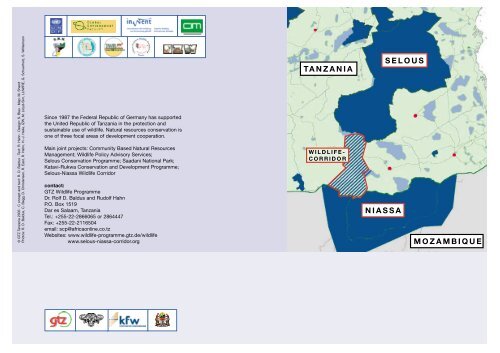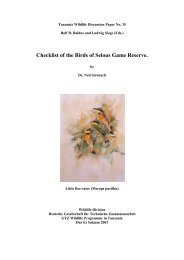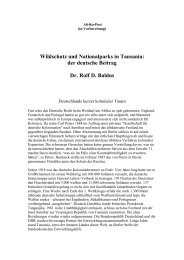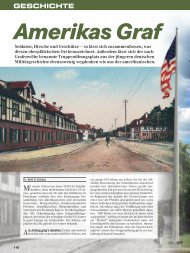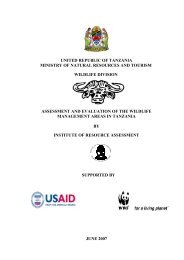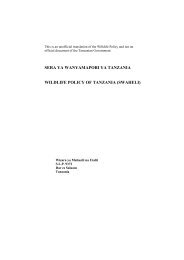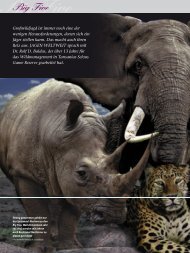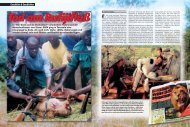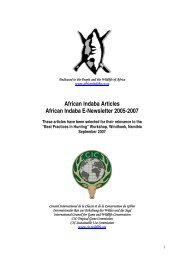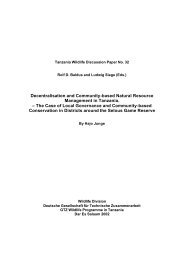TANZANIA NIASSA SELOUS MOZAMBIQUE - wildlife-baldus.com
TANZANIA NIASSA SELOUS MOZAMBIQUE - wildlife-baldus.com
TANZANIA NIASSA SELOUS MOZAMBIQUE - wildlife-baldus.com
Create successful ePaper yourself
Turn your PDF publications into a flip-book with our unique Google optimized e-Paper software.
© GTZ Tanzania 2005 · C oncept and text: R. D. Baldus · Text: R. Hahn · Design: S. Blau · Map: M. Shand<br />
Photos: R. D. Baldus, C. Begg, D. Christensen, R. East, R. Hahn, H.-J. Heile, IZW, M. Lloyd-Sim, LUWIRE, G. Schuerholz, S. Williamson<br />
Since 1987 the Federal Republic of Germany has supported<br />
the United Republic of Tanzania in the protection and<br />
sustainable use of <strong>wildlife</strong>. Natural resources conservation is<br />
one of three focal areas of development cooperation.<br />
Main joint projects: Community Based Natural Resources<br />
Management; Wildlife Policy Advisory Services;<br />
Selous Conservation Programme; Saadani National Park;<br />
Katavi-Rukwa Conservation and Development Programme;<br />
Selous-Niassa Wildlife Corridor<br />
contact:<br />
GTZ Wildlife Programme<br />
Dr. Rolf D. Baldus and Rudolf Hahn<br />
P.O. Box 1519<br />
Dar es Salaam, Tanzania<br />
Tel.: +255-22-2866065 or 2864447<br />
Fax: +255-22-2116504<br />
email: scp@africaonline.co.tz<br />
Websites: www.<strong>wildlife</strong>-programme.gtz.de/<strong>wildlife</strong><br />
www.selous-niassa-corridor.org<br />
<strong>TANZANIA</strong><br />
WILDLIFE-<br />
CORRIDOR<br />
<strong>NIASSA</strong><br />
<strong>SELOUS</strong><br />
<strong>MOZAMBIQUE</strong>
Towards Transboundary Conservation<br />
The Selous-Niassa Wildlife Corridor in<br />
Southern Tanzania
Strengthening the Selous Game Reserve<br />
With an area of around 48,000 km 2 , representing 6% of Tanzania's land surface, the World Heritage Site<br />
Selous Game Reserve is the largest single protected area in Africa. It is also the oldest, dating back to<br />
1896. Its major value lies in the fact that it is a huge wilderness area - the size of Switzerland - with no<br />
human encroachment and little interference. The reserve contains populations of elephants, buffaloes,<br />
antelopes, wild dogs and lions of continental significance. Through decades of protection, natural<br />
processes have been allowed to continue unhindered and indeed many parts of the reserve nowadays<br />
contain more <strong>wildlife</strong> than a century ago.<br />
However, during the 1980s the rapid increase in poaching for ivory and rhino horn led to a serious<br />
decline of elephants and rhinos and threatened the reserve’s survival. In partnership with the Federal<br />
Republic of Germany, the Wildlife Division of the Ministry of Natural Resources and Tourism, Tanzania,<br />
rehabilitated the reserve through the joint Selous Conservation Programme, which ran from 1987 until<br />
2003, and turned it into a self-financing conservation area.<br />
Creating Wildlife Management Areas<br />
Conservation efforts did not end at the reserve’s boundaries. For the integration of local <strong>com</strong>munities and<br />
the establishment of support-zones outside the reserve a specific Tanzanian concept was developed and<br />
applied. Community-based natural resources management and in particular village Wildlife Management<br />
Areas (WMA) are the major <strong>com</strong>ponents. In a participative process of land-use planning, local <strong>com</strong>munities<br />
designate areas in which they conserve and manage <strong>wildlife</strong> and other natural resources. Revenues accrue<br />
to them. Thus WMA contribute not only to conservation but equally importantly to development and<br />
poverty alleviation in the rural areas. WMA are a core element of the Wildlife Policy of Tanzania (1998).<br />
Deutsche Gesellschaft für Technische Zusammenarbeit (GTZ) supports the Wildlife Division in the<br />
establishment of WMA south of the Selous Game Reserve. There, in cooperation with local and district<br />
authorities, villages are registering two WMA with a total area of approximately 4,500 km 2 .
A Good Neighbour - Niassa Game Reserve<br />
The Niassa Game Reserve in neighbouring Mozambique is the largest conservation area in the country,<br />
covering 42,000 km 2 . It contains the greatest concentration of <strong>wildlife</strong> in Mozambique. The Ruvuma river<br />
forms the northern boundary of the Niassa Reserve and the border with Tanzania. The reserve consists<br />
of a core area of 22,000 km 2 and a support zone <strong>com</strong>prising an additional 20,000 km 2 .<br />
In contrast to the Selous there are a number of villages inside the protected area. This poses both a challenge<br />
and an opportunity to its management. The Niassa Reserve is managed through a public-private partnership,<br />
Sociedade para a Gestao e Desenvolvimento da Reserva do Niassa, with its current major donor and<br />
technical partner Fauna & Flora International.<br />
Selous – Niassa Wildlife Corridor<br />
The Selous-Niassa miombo woodland ecosystem as a whole is one of the largest trans-boundary ecosystems<br />
in Africa, covering 150,000 km 2 , and extends across southern Tanzania into neighbouring Mozambique.<br />
The many habitats, including forests, wooded grasslands, open savannahs, granite kopjes, seasonal and<br />
permanent wetlands and rivers support a wide biodiversity which is globally significant. The core conservation<br />
areas for its continued existence are:<br />
- the Selous Game Reserve<br />
- the Niassa Game Reserve<br />
- forest reserves<br />
Together these areas constitute the world’s largest elephant range. The corridor is central to this range.<br />
The corridor is sparsely settled by small farmers who have lived side by side with the <strong>wildlife</strong> since time<br />
immemorial. The task ahead will be to find a balance between their development needs and the conservation<br />
of nature. The long term existence of the corridor will be in their hands.<br />
However, there are severe threats to its continued existence which could block this important link. These<br />
include uncontrolled conversion of land for agricultural use, destructive agricultural practices, unsustainable<br />
and illegal use of natural resources, cross-border poaching, bush meat trade, illegal logging, destruction of<br />
forests and uncontrolled bushfires.
Corridor Research Project - Laying the Foundations<br />
The Tanzanian conservation authorities, the District administrations and a number of <strong>com</strong>munities agree in principle<br />
that there is need for better conservation of the corridor. Following this important agreement, a research project was<br />
carried out from 2000 to 2003 by a partnership of Tanzanian and German research institutions. The major scientific<br />
input came from the Berlin based Institute of Zoo Biology and Wildlife Research. The objective of the project was to<br />
develop a sound scientific foundation for the planned conservation activities.<br />
A <strong>com</strong>bination of state-of-the-art technology such as satellite tracking of elephants, <strong>com</strong>bined with local indigenous<br />
knowledge, proved that the planned <strong>wildlife</strong> corridor provides a significant biological landscape linkage that is important<br />
to the integrity of the greater ecosystem.<br />
Key results like ecosystem description and identification of migration routes, <strong>wildlife</strong> population sizes and human-<strong>wildlife</strong><br />
conflict areas will assist the long-term conservation of the corridor.
Advisory Services to the Districts<br />
Since early 2005 a technical advisor has been working in the corridor as an integrated expert employed by the<br />
District Authorities. He was placed by the German Centre for International Migration and Development (CIM). The<br />
integrated expert supports the Namtumbo and Tunduru Districts of Ruvuma-Region and their <strong>com</strong>munities in the<br />
sustainable management and utilisation of their natural resources and the establishment of WMA.<br />
GTZ – InWent Dialogue<br />
The Natural Resources and Biodiversity Division of InWent (Capacity Building International, Germany) focuses on<br />
resources policy, ecosystem management and regional cooperation. Since 1998 InWent has been assisting in<br />
policy development and capacity building, aiming at regional partnerships in Southern and Eastern Africa, including<br />
Tanzania and Mozambique.<br />
To facilitate trans-boundary dialogue InWent has launched the capacity building programme TRANSNET:<br />
Trans-boundary and sustainable management of natural resources for regional integration and rural development in<br />
the SADC and EAC regions.
The Selous-Niassa Wildlife Corridor Project<br />
The Government of Tanzania initiated the conservation of the corridor in 2005 with support from the Global<br />
Environment Facility/UNDP. The project “Development and Management of the Selous-Niassa Wildlife Corridor”<br />
will extend <strong>com</strong>munity-based natural resources management from the southern support-zone of the Selous<br />
towards the border with Mozambique. Villages in Namtumbo and Tunduru Districts will be able to establish a<br />
network of WMA linking the Selous and Niassa Game Reserves. Benefits from sustainable natural resources<br />
management will enhance the livelihood security of rural poor and enhance the long-term conservation of the<br />
corridor. “GTZ-International Services” is implementing this cooperation project of the Wildlife Division and UNDP.<br />
In late 2004 the District Authorities, GTZ and the “Mtwara Development Corridor” conducted a joint planning study<br />
for tourism development, <strong>wildlife</strong>-based industries and participatory forest management along the Ruvuma river<br />
Interface. With increasing dialogue and cross-border cooperation this region could develop into one of the world`s<br />
largest trans-frontier conservation areas, contributing to the protection of the environment and its <strong>wildlife</strong>, poverty<br />
reduction and peace.<br />
New Partnerships for Future Cooperation<br />
The Federal Republic of Germany will make available substantial funds to further support the development of the<br />
Selous-Niassa Wildlife Corridor. The funds will be channelled through the German Development Bank KfW.<br />
The project aims to initiate the economically sustainable development and conservation management of one of the<br />
most significant, widely recognized <strong>wildlife</strong> corridors in the SADC Region. The goals are the conservation of<br />
biodiversity in the miombo woodland ecosystem and the overall improvement of the livelihoods within local <strong>com</strong>munities<br />
through the sustainable use of natural resources to <strong>com</strong>bat poverty. The project will be based on previous GTZ<br />
experiences and designed and implemented in cooperation with the Global Environment Facility/UNDP project.<br />
Both projects will <strong>com</strong>plement each other.<br />
Financing operations shall be, inter alia, directed towards<br />
- establishing additional village Wildlife Management Areas through development of land use<br />
and management plans, <strong>com</strong>munication facilities and equipment of game scouts<br />
- support to relevant district game and land offices<br />
- investment support to the Community-based Conservation Training Centre Likuyu


